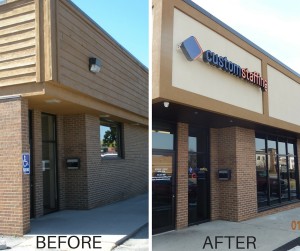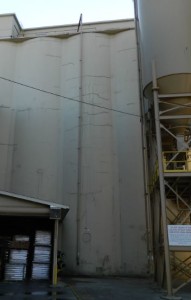Custom Staffing, a leading staffing agency in Ohio, offers help filling positions such as temporary, temp-to-hire, direct hire, large project based workforce, and individually qualified candidates. The agency operates ten offices and offers a wide range of employment opportunities to thousands of job seekers at every level. Read more »
Read more »
Exterior Insulation Finish Systems (EIFS) have been used as the façade finish for over thirty years in this country. In order to properly maintain and restore this type of exterior finish, it is important to know how the system was installed. Read more »
We have all heard the old adage, “If these walls could talk!” It turns out that the walls of our buildings do in fact talk to us in a way. Whether it is structural or due to lack of maintenance, our walls have certain ways of telling us things. Building movement can result in wall cracks, fractures, dislocated masonry or other visible damage. So if walls could talk, what might they be trying to tell us? Read more »
The purpose of this article is to discuss concrete fracturing. What is it, and what are the causes? What do you need to be looking for, and how can the issues be taken care of? When it comes to concrete fracturing, there are many signs to be on the lookout for in order to prevent an increased risk of rebar corrosion and premature concrete damage. Read more »
Read more »
2016 is here. With a new year comes change, progress, improvements, and sometimes failures. Each year is sure to be different than the last and at the beginning of a new year, it’s prudent to try and look ahead to try and anticipate what will be occurring in your industry so that you can be prepared for what’s to come. In 2016, these are some of the trends that we feel all of us in construction need to be aware of.
Shortage of Trades People. Fortunately, projections for 2016 indicate a strong year for construction which means plentiful employment opportunities for workers. Unfortunately, that puts employers in a difficult position when taking on additional work. Typically, in the winter months, contractors have many workers laid off as the cold weather restricts work. As the temperatures rise, the workers go back to work to perform the jobs that were bid over the winter months. Due to plentiful opportunities this year, many contractors already seeing record backlogs and as they look for potential projects to bid, they are concerned with having enough manpower. It’s a double-edged sword, there is an abundance of potential work, but if there isn’t enough manpower to complete that work and it could be very costly to a contractor thus eroding potential profits. One of the side results is that contractors are not bidding projects because they simply can’t perform them, which in the world of supply and demand results in increased prices.
Resurgence of Vocational Schools. With the shortage of tradespeople, there seems to be a resurgence of vocational schools. Because many businesses are in need of skilled workers, vocational schools are becoming a more popular option. During the most recent economic downturn most high school students were driven to attending a two or four-year university. The result of this was a record loss of tradespeople the likes of which have never before been seen in this country. As this phenomenon becomes more understood vocational schools are rallying to try and educate students to the merits and rewarding careers that are available in the building trades. Hopefully this resurgence will help to build a new population of skilled trades workers for the manufacturing and construction industries.
Union labor vs. right-to-work states. Right-to-work laws were established to minimize the power of unions especially with regards to controlling the hourly wage and the benefit packages. Union labor rates have traditionally established the prevailing wage for both union members and nonunion workers in unionized sectors; research shows that both union and nonunion workers in right-to-work states have lower wages and benefits than similar workers in other states. In other research, it has been shown that wages in right-to-work states are 3.2 percent lower on average than wages in non-right-to-work states. It was also found that workers in right-to-work states are less likely to have health insurance and pension coverage covered by their employer.
If any of these 2016 trends are going to affect you and your industry, make sure you are prepared to handle them. You may have to go the extra mile to seek out employees that have the skills and qualities you need. Make sure that you are keeping up with your competitors by offering competitive salaries and benefits for your future employees. Make sure that you are staying ahead of your competitors by creating an aggressive recruitment program. Do your best to always stay up-to-date in all of the latest industry trends.
Source: http://www.epi.org/publication/right-to-work-states-have-lower-wages/
Therma-Tru’s corporate office building had been leaking for years. After numerous unsuccessful attempts to correct this condition, Trisco Construction Services, LLC (TCS) was brought in by Mariucci & Associates to determine the source of leaks and to design/install the repair method. Read more »
Read more »
The holiday season is here! During the holiday season, we tend to completely dismiss any goals we once had of being healthy or staying in shape. While you shouldn’t let staying healthy prevent you from indulging in some of your favorite holiday treats or from having any fun, there are ways to still stay on top of your health and wellness during the holiday season. This season, make sure you stay happy AND healthy with these simple tips. Read more »
Read more »
The entire Trisco family mourns the loss of 70-year employee Verlin C. Herndon. Verlin touched the lives of so many of us inside and outside of the Company. Rest in Peace Verlin.
http://www.examiner.org/obituaries-2/58319-verlin-c-herndon
The purpose of this article is to briefly discuss common sealant failures and the installation considerations for restoration and maintenance projects. The replacement of your building’s sealants should be treated as a scheduled maintenance item, just like an oil change on your car. Sealants are used in exterior wall construction to prevent the passage of liquids, light, or gases between two materials despite differential movement between those components. Even the best barrier, drainage, and diversion systems will not work if the sealant joints are not properly designed, configured, and installed. The majority of sealant failures are due to faulty joint installation or the use of the wrong sealant. Read more »
The purpose of this article is to briefly discuss sealants and design considerations for restoration and maintenance projects. The replacement of your building’s sealants should be treated as a scheduled maintenance item, just like an oil change on your car. The life expectancy of a sealants varies, but replacement should be evaluated every 10-15 years. Commonly confused with caulking, sealants accommodate movement whereas caulk is used to simply fill a void within a component. Sealants are used in exterior wall construction to prevent the passage of liquids, light, or gases between two materials despite differential movement between those components. It is important for anybody considering a sealant restoration project to understand the different types of joints, sealants, design considerations, and installation procedures. Read more »

